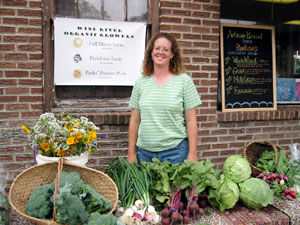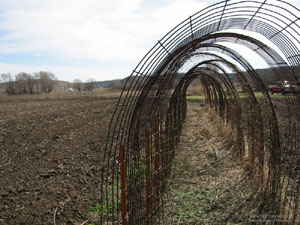
Jane with a Harvest of her Spring Vegetables
Jane Drake, owner of Full Moon Farm, is an organic vegetable grower in Riley County, Kansas. In the past the outlet for her produce has been local farmers’ markets and wholesale sales to small retail markets in the surrounding area. This year Jane intends to start a subscription vegetable service in which local residents sign up to purchase $12-15 of her vegetables each week from mid-May through September. She will not produce crops during the winter.
Jane’s Situation
A 360 degree view of the site taken from the hooped trellis. (click on the picture to drag image around in the frame or refresh the page to watch panoramic again)

Jane’s main objectives for the construction and use of two new high tunnel structures are season extension, improved plant microclimate, increased farm income by remaining in the market longer, and support of her new marketing strategy evolving around the subscription service.
Intended crops for these structures include salad mix, braising mix, and head lettuce in one high tunnel and tomatoes and cucumbers in the other tunnel. Jane rents a three-acre plot of land in Riley County, Kansas, from an organic swine production operator. She and her landlord have a good farming relationship and often work together to solve problems and share equipment.
Because Jane is renting this acreage from season to season, one stipulation is that all structures that she builds must be removable with minimal effort and at a moment’s notice; that is, nothing that Jane constructs can be considered permanent.
Logically then, she does not want to tie up a large amount of capital in these high tunnels. Therefore, the design that she has chosen is inexpensive, and its structural integrity is comparatively weak. Jane intends to construct two small high tunnels, ten feet wide by forty feet long, which will each contain two raised beds for production of crops. Jane needs to decide not only where to place her high tunnels on her farm site, but also how to orient them at that spot. There are many factors and issues to consider before she decides on final placement. The material that she will use for her 10′ X 40′ tunnels are PVC pipe frame ribs covered with three-year 6-mil plastic. The PVC ribs will be spaced at three foot intervals and driven two feet into the ground. The end walls will be framed with lumber and covered with the same 6-mil plastic. The interior will be approximately seven feet high in the middle.
Site Planning
The Site
View the Full Moon Farm Site PlanSeveral farm access roads intersect her plot, which is a convenience in many cases, but these roads are also an important consideration in planning for high tunnel placement. The high tunnels must be far enough from the roads so that no possibility of snagging would occur from farm machinery that travels the road; likewise, machinery should not have to be maneuvered around the tunnels. Machinery is also often pulled along the north tree row. Other features of the site include water pump, electricity source, vining plant trellis, and post harvest handling and equipment sheds. Proximity of high tunnel placement to these resources should maximize labor efficiency. As mentioned before, the sheds cannot be permanent structures and are built on skids for quick and easy removal if warranted. So, this dictates that water lines cannot be permanently plumbed to the high tunnels. The site plan (Exhibit 1) shows all of these structures, as they have already been built. Note that the pump house is a permanent structure maintained by the owner.

Existing Trellis for Vegetables
Existing Trellis for Vegetables
Jane has access to this pump house to use the well water for the irrigation of her crops. She uses a thick-walled rigid header hose with filters and many outlets so that she can then hook up hoses as needed for drip irrigation or other watering. Jane may occasionally need electricity in her high tunnels. For example, if a cold snap threatens the crops, supplemental heat would be needed. Also, she will routinely use heating pads for germinating seeds.
The Climate
Riley County is in the Northeastern portion of Kansas. The largest city in Riley County is Manhattan, which is home to Kansas State University. On average, the area is bestowed with more clear sunny days than cloudy days. Historical data averages for the general climatic conditions are as follows: 145 clear days, 126 partly cloudy days, and 94 cloudy days per year. The average yearly precipitation is 34.80 inches with snowfall accumulation of 15 inches per year. In general, snowfall during one storm is no more than 5 inches. There are about 179 frost-free days in the growing season, and the last killing frost occurs on April 18 on average. However, May 9 is considered the frost-free date with only a 5% chance that a frost will occur after that date. The average first killing freeze in the fall is October 15. The annual mean temperature is 55°F; however, this average does not reveal the extreme cold winters and hot summers that Kansas experiences.
USDA Hardiness ZonesOn average the warmest month is July, however, many Kansans would argue that the first weeks of August are when the most oppressive heat occurs. Temperatures in the summer months typically creep above the 100°F mark. The coldest month on average is January, with February close behind and often when the coldest temperatures for the season are recorded. Wind is another climatic factor that plays a role in many Kansans’ lives, especially those in agricultural industries. In fact, the state name “Kansas” is derived from the Native American Kansa tribe indigenous to the region, and in their language, “Kansa” refers to winds, or wind people.

Stand of mature trees protect site from north wind.
The windiest months are March and April; the calmest are July and August. Average hourly wind velocities in March and April are between 9.8 and 14.3 mph, the windiest time of day is between noon and 3pm. Keep in mind that these are averages and it is not uncommon for typical spring storms to bring 50 mph wind gusts. This is in contrast with the calmest month of August, where wind velocities peak at 10 mph and usually hover around 6 mph. From April to approximately December, prevailing winds are from the south. Otherwise northerly winds prevail with the shift occurring usually in January when winds are often from the northwest. The location of tree stands that may serve as wind breaks are (1) a scraggly hardwood tree row bordering the pump-house and other structures along the western access road, and (2) a mature stand of deciduous trees approximately fifty feet tall on the north edge of the property.
Questions
Jane has spent a considerable amount of time researching her decision. She has read books, articles, and looked on-line to find information. In addition, Jane has talked to growers who use high tunnels and university extension specialists in horticulture.
Brainstorming Notes ExampleThe PDF file is an example of the final brainstorming process that Jane went through to make her decision. How would you respond to the questions that she poses? Teaching Notes. If you have any questions, comments or would like to receive teaching notes pertaining to this case study please contact: Kimberly A. Williams, Professor of Floriculture Kansas State University Department of Horticulture, Forestry, and Recreation Resources 2021 Throckmorton Plant Sciences Center Manhattan, Kansas 66506-5506 kwilliam@ksu.edu




